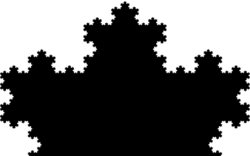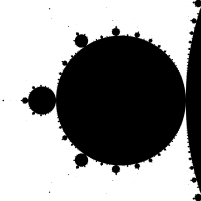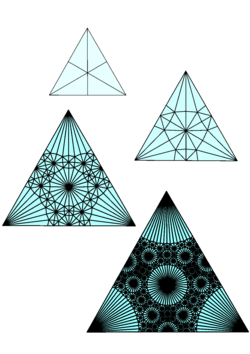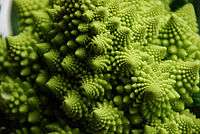Self-similarity

In mathematics, a self-similar object is exactly or approximately similar to a part of itself (i.e. the whole has the same shape as one or more of the parts). Many objects in the real world, such as coastlines, are statistically self-similar: parts of them show the same statistical properties at many scales.[2] Self-similarity is a typical property of artificial fractals. Scale invariance is an exact form of self-similarity where at any magnification there is a smaller piece of the object that is similar to the whole. For instance, a side of the Koch snowflake is both symmetrical and scale-invariant; it can be continually magnified 3x without changing shape. The non-trivial similarity evident in fractals is distinguished by their fine structure, or detail on arbitrarily small scales. As a counterexample, whereas any portion of a straight line may resemble the whole, further detail is not revealed.
A time developing phenomenon is said to exhibit self-similarity if the numerical value of certain observable quantity measured at different times are different but the corresponding dimensionless quantity at given value of remain invariant. It happens if the quantity exhibits dynamic scaling. The idea is just an extension of the idea of similarity of two triangles.[3][4][5] Note that two triangles are similar if the numerical values of their sides are different however the corresponding dimensionless quantities, such as their angles, coincide.
Self-affinity

In mathematics, self-affinity is a feature of a fractal whose pieces are scaled by different amounts in the x- and y-directions. This means that to appreciate the self similarity of these fractal objects, they have to be rescaled using an anisotropic affine transformation.
Definition
A compact topological space X is self-similar if there exists a finite set S indexing a set of non-surjective homeomorphisms for which
If , we call X self-similar if it is the only non-empty subset of Y such that the equation above holds for . We call
a self-similar structure. The homeomorphisms may be iterated, resulting in an iterated function system. The composition of functions creates the algebraic structure of a monoid. When the set S has only two elements, the monoid is known as the dyadic monoid. The dyadic monoid can be visualized as an infinite binary tree; more generally, if the set S has p elements, then the monoid may be represented as a p-adic tree.
The automorphisms of the dyadic monoid is the modular group; the automorphisms can be pictured as hyperbolic rotations of the binary tree.
A more general notion than self-similarity is Self-affinity.
Examples


The Mandelbrot set is also self-similar around Misiurewicz points.
Self-similarity has important consequences for the design of computer networks, as typical network traffic has self-similar properties. For example, in teletraffic engineering, packet switched data traffic patterns seem to be statistically self-similar.[6] This property means that simple models using a Poisson distribution are inaccurate, and networks designed without taking self-similarity into account are likely to function in unexpected ways.
Similarly, stock market movements are described as displaying self-affinity, i.e. they appear self-similar when transformed via an appropriate affine transformation for the level of detail being shown.[7] Andrew Lo describes stock market log return self-similarity in econometrics.[8]
Finite subdivision rules are a powerful technique for building self-similar sets, including the Cantor set and the Sierpinski triangle.

In nature

Self-similarity can be found in nature, as well. To the right is a mathematically generated, perfectly self-similar image of a fern, which bears a marked resemblance to natural ferns. Other plants, such as Romanesco broccoli, exhibit strong self-similarity.
In music
- Strict canons display various types and amounts of self-similarity, as do sections of fugues.
- A Shepard tone is self-similar in the frequency or wavelength domains.
- The Danish composer Per Nørgård has made use of a self-similar integer sequence named the 'infinity series' in much of his music.
- In the research field of music information retrieval, self-similarity commonly refers to the fact that music often consists of parts that are repeated in time.[9] In other words, music is self-similar under translation, rather than (or in addition to) under scaling.[10]
See also
References
- ↑ Mandelbrot, Benoit B. (1982). The Fractal Geometry of Nature, p.44. ISBN 978-0716711865.
- ↑ Mandelbrot, Benoit B. (5 May 1967). "How long is the coast of Britain? Statistical self-similarity and fractional dimension". Science. New Series. 156 (3775): 636–638. PMID 17837158. doi:10.1126/science.156.3775.636. Retrieved 11 January 2016. PDF
- ↑ Hassan M. K., Hassan M. Z., Pavel N. I. (2011). "Dynamic scaling, data-collapseand Self-similarity in Barabasi-Albert networks". J. Phys. A: Math. Theor. 44: 175101. doi:10.1088/1751-8113/44/17/175101.
- ↑ Hassan M. K., Hassan M. Z. (2009). "Emergence of fractal behavior in condensation-driven aggregation". Phys. Rev. E. 79: 021406. doi:10.1103/physreve.79.021406.
- ↑ Dayeen F. R., Hassan M. K. (2016). "Multi-multifractality, dynamic scaling and neighbourhood statistics in weighted planar stochastic lattice". Chaos, Solitons & Fractals. 91: 228. doi:10.1016/j.chaos.2016.06.006.
- ↑ Leland et al. "On the self-similar nature of Ethernet traffic", IEEE/ACM Transactions on Networking, Volume 2, Issue 1 (February 1994)
- ↑ Benoit Mandelbrot (February 1999). "How Fractals Can Explain What's Wrong with Wall Street". Scientific American.
- ↑ Campbell, Lo and MacKinlay (1991) "Econometrics of Financial Markets ", Princeton University Press! ISBN 978-0691043012
- ↑ J. Foote (1999), Visualizing music and audio using self-similarity. '99 Proceedings of the seventh ACM international conference on Multimedia (Part 1), Pages 77-80, New York, NY, USA
- ↑ G. Pareyon (2011), On Musical Self-Similarity
External links
- "Copperplate Chevrons" — a self-similar fractal zoom movie
- "Self-Similarity" — New articles about Self-Similarity. Waltz Algorithm
Self-affinity
- "Self-affinity and fractal dimension" (PDF). Physica Scripta. 32: 257–260. 1985. doi:10.1088/0031-8949/32/4/001.
- Victor Sapozhnikov and Efi Foufoula-Georgiou (May 1996). "Self-affinity in braided rivers" (PDF). Water Resources Research. 32 (5): 1429–1439. Bibcode:1996WRR....32.1429S. doi:10.1029/96wr00490.
- Benoît B. Mandelbrot. Gaussian Self-Affinity and Fractals: Globality, the Earth, 1/F Noise, and R/S. ISBN 0387989935.